SEMESTER 2
During this semester, I have focused on continuing with the development of the ideas I established last year. To begin with, I have finished animating the Glass Chain project commissioned by Cath Keay. I have a final draft, which only needs music to be completed. In conversation with Cath, we have explored the possibility of having a Jazz Quartet improvise in response to the animation. Given its abstract and loose narrative, it would be interesting to see how musicians would react when faced with it. Also, we have contemplated the idea of having a friend of Cath create the musical score for the piece, using the glass instruments of a “Glass Orchestra" she is a part of.
I am satisfied with the results obtained from the process of creating this animation. I was challenged to find new ways of animating with oil on glass, experimenting with painted backgrounds that served as backdrops for the movement of the paint, and which were covered or allowed to be seen selectively, creating conversations amongst colours and levels that I hadn’t encountered before. Also, I made visible the physical nature of using a thick, dense, textured and fluid material such as oil paint. There are moments in which it is possible to see the flakes of dry paint that resulted from scraping the oil from the glass, which created an added dimension of movement and texture within the piece. There is an implicit lack of control in the chaotic “mess” of scraping paint from glass that beautifully contrasts with the subdued and methodical animation made with the oil paint, which moves in a straightforward and mostly linear way. I would be interested in exploring this more in the future, finding ways of utilizing randomness and entropy intrinsic to the physical act of painting to create animations that feel less structured and continuous in their movement, as well as charged with a painterly expressiveness that digital techniques couldn’t replicate. A type of movement which is unplanned, chaotic and jittery can be allowed to flourish, which I find to beautifully express the complexity of natural movement, in contrast to the controlled yet almost artificial way man-made things move. I want to expand on this in my personal project, as will be outlined further.
During the process of editing the footage into a single piece I was challenged to find ways of transitioning and composing the images to emphasize certain actions and create a rhythm and flow that connected the different parts. At some point, I contemplated explicitly eliciting the narrative of the action by means of a voice over or subtitles, but in the end decided to leave the piece as an open and abstract interpretation of the “script” written by Wenzel Hablik, “The building of a glass house next to the sea”. I created this piece as a loosely based response to a fantastic, brief and descriptive script, that depicted situations that would have been impossible to illustrate in the 1920´s, but which contemporary animation techniques could easily handle. However, given my lack of knowledge in 3D animation and my interest to further explore the technique of oil on glass, I decided that the transparent, fluid, textured and brightly coloured pieces that could be made with oil would directly homage with the fact that Hablik himself was a painter, who created beautiful visions of buildings and landscapes using traditional techniques. I find that oil on glass is a technique that allows for a spontaneous creative process, in which things transform as they are made and colours and shapes transform naturally and sinuously on the canvas. The fact of not being able to easily correct what has been made brings forth a very slow and pensive way of creating, which I find fits practice and challenges me to focus and experiment. It forces me to think of animation as a physical, present, and spontaneous improvisational act, akin to painting or making collage, which are the keystones of my work as an artist interested in natural forms, which engage audiences because of their capacity to illustrate the richness, depth and poetry of nature’s rhythms and forms.
Parallel to this, I have continued working on my personal project. I have settled on the central premise of:
“A character finds a tree that grows amidst a mountain of decaying flesh. Its fruit, pulsating with the strange movement of fractals, catches his eye. He extends his hands, made fractal by the fruit, and grabs it, peering into it. He then inoculates it with a technological sperm, which causes the pulsating, chaotic fruit to suddenly begin evolving: with a bang, the chaos begins the process of order.
First, the chaotic mass of random particles resultant from the initial bang coalesce into the cosmic web, shaped by the underlying fluctuations in gravity caused by dark matter. Within the nodes of this web, galaxies form, in many shapes and sizes, made of stars and their respective systems: planets, asteroids and moons are made from whirlpools of dust and gas, which gravity transforms into the spherical orbs we know. The inherent laws of the universe, the ways in which things cause each other, lead to the formation of the specific structures which compose the cosmos to arise.
After this, the film will focus on one of these planets, which the character observes, given that it seems to be slowly forming life, which interests him. At some point, inevitably, within the layers of thick mud resultant from the appearance of water, random molecules are arranged in less and less chaotic ways, resonating with the energy that comes from the sun, which incites a specific order to arise. This forces them to slowly align into shapes, eventually binding them together and allowing for chemical bonds to fuse when lighting or lava adds bursts of energy. Eventually, they reach a state in which, purely from the physical and chemical consequences of their shapes, they are capable of replicating, harvesting loose particles around them to form clones of themselves, which in turn replicate themselves. Thus, the arms race of natural selection begins. Those capable of better replicating have more offspring, and thus, evolution is put in march. Complexity arises as molecular systems find better and better ways of surviving, consuming others, reproducing with them, or forming proto-organs which allow them to defend, attack, perceive or move. This process is driven by randomness, in which alterations occur out of the natural tendency for things to, simply put, not be perfect: the replicants make mistakes in the copying process, which, occasionally, are beneficial to the clone.
The character observes this, and understands that it echoes all the previous processes he has encountered as the universe arose. The same way that gravity made the primordial soup of energy coalesce into particles, and eventually into matter, or the same way that stars arose from denser spots in space, causing the amalgamation of matter into increasingly energetic spheres, he can see that life is a continuation of this primordial principle: a consequence of the natural principle of things tending to find ways of stabilising into systems capable of dispersing energy, and thus, transforming it. And this, in fact, is simply the consequence of the inherent rules of the universe itself: they are physical consequences of the way things work. What occurs at one scale is replicated in the scale within: the forms and shapes which mandate the processes of transformation and change are self-similar, occurring at every level. The character, with his greater scope of vision, can see this easily, zooming into specific parts of the process and perceiving specific moments where this is evident.
Eventually, as the new-born life evolves across millennia, increasing in complexity and sophistication, mammals arise, and, at some point, monkeys become conscious. Humans appear, and begin the long journey of history. Excited, the character observes how they reach stepping stones in their technological development, slowly gaining better ways of communicating information and utilizing their environments in ways that make them better and better at surviving. At the root of their success, he notices, is their capacity to work in communities, which allows them to transfer information effectively and build webs that allow effective transfer of ideas and objects. Instead of lone particles in the void, they behave like the gravity-bound atoms that team up to form increasingly complex astral objects. He observes how they seem to perceive, at different moments of their history, the holographic beauty he has seen before: the way nature echoes itself time and time again, revealing an inherent order that intrinsically works in certain ways, allowing change to refine chaotic configurations into more stable, less entropic states, in which things essentially work together to oppose disorder. Particles coalesce into webs, which are solid amongst the cold, entropic void; stars are made by gravity, allowing gas to form into spheres of life-giving fire; planets are the conjunction of millions of rocks dispersed into the void by supernovas into larger, more solid and stable orbs. Nature seems to playfully cause change into stability time and time again, and it seems to him that cooperation is the root of this. Things tend to form cooperative systems of solidity and stability. And, he delightedly observes, the humans are learning this, working in communities to create complex technologies – temples, castles, and, he notes, sharper and sharper weapons. Death, he knows, is part of life; it is embedded in change. It is simply the by-product of nature’s capacity to transform.
Eventually, societies reach a point in which they have a deeper understanding of the forces that dictate the way nature occurs. They have decoded gravity, and the way mass bends space to make things attract each other. They have deciphered electromagnetism, and the interplay between electrons and their fields to create electricity. They have understood the nuclear forces, and the way particles behave. They have unveiled relativity, and the fundamental nature of spacetime as a single, unified concept that relates mass and energy as single manifestation. They have observed quantum physics, and the paradoxical nature of particles, which are probabilistic and determined by the specific act of observation. And, they have used these understandings to create technology so sophisticated they can communicate across distance, fly over oceans, and observe the universe with unfettered detail. The being realizes that they are quickly approaching a moment where they will be capable of peering so deeply they will wield energy just like stars do, and create systems so sophisticated they shall have control over their bodies and minds to transcend the physical limitations of their nature. They will refine their power over substance to create systems so effective that they shall enact as a species the next step in the long chain started by him igniting the universe-fruit he harvested: they shall observe that they are a leaf upon the fern, and that leaf, itself, a fern made of leaves: spiral, web, sphere, all simply the myriad forms that the single fruit takes in its capacity to transform. They are, in their specific scale, the refinement of a universe into looking upon itself, its own nature, and concluding that it is, in the end, one. And, thus, the fruit he harvested might give him a friend. When the fruit observes itself, he knows, one like him shall be born.
But, in horror, he realizes that in their excessive speed, the humans are also falling prey to the chaos of power. They can’t see that the source of their success is their capacity to talk, to dialogue, to work as one. They have set up a system that separates the particles of consciousness into fragmented elements, incapable of talking and working as one. And, in doing so, they are in complete lack of interface with the Earth they inhabit: they aren’t organically fitting into the fractal order of things, which reveals itself in every shape of Nature. Instead, obsessed with the straight line of themselves as individuals, as units, they are causing a very quick loss of energy that is burning away the balance intrinsic to the planetary system, spending resources before the system can adjust and grow. He doesn’t understand why, in their immense intellect, they don’t realize how unique they are. He realizes that though life is common in the universe, it is very rare for it reach the point of complexity and advancement that holds the potential of birthing a new type of consciousness. He can’t do anything, except hope the humans will realize how special they are, and what a waste their extinction would mean…”
This piece has condensed a lot of the research I have done throughout the year into a narrative sequence that attempts to tell the story of how science believes the universe was created. It does so by using specific images and processes as an initial point to design an animation that encapsulates the specific way in which certain shapes and systems of nature repeat amongst different scales, and the way in which this pertains to humankind’s endeavours, in a historic moment where we are walking on a tightrope in terms of climate and consumption. From my research, I have concluded that there is a definitive interference between nature’s way of operating and humanity’s recent revolution, which has created a world exemplified by the straight edge of individuality, unfettered progress and savage capitalism. A merely superficial observation of nature, in her primal beauty and creative power, reveals that things tend to increase in complexity by creating systems, in which entropy is reduced by means of structures, patterns and algorithms which are characterized by feedback loops and high efficiency in the transfer of information. This is often done by encapsulating elements within self-similar containers, thus creating a harmonic order that can be replicated at different scales. Analysing nature at any scale reveals this order: the cosmic web, in which the hazy and chaotic primal gas became condensed in specific shapes that allowed for the formation of galaxies, uses the same structure of web-like filaments that certain type of moss, neurons and spider webs. Spirals are visible in flowers, shells, galaxies, and whirlpools. Circles occur in wave-patterns, planets, galaxies or fruits. Fractals, as a general concept, are a mathematical model for condensing infinite complexity with simple algorithms that, when reiterated, create not only beautiful but highly effective ways of displaying, containing or generating information. Nature does things perfectly, in the sense that there is no externality to nature, no other way of proceeding. Nature is, inherently, its laws – there is no other way of things being what they are, except for the way in which they naturally occur. Humans, as observers, can particularize and try to separate these laws into specific compartments – yet we are nothing but a product of nature as well. Perhaps our feeble attempts at creating a different order, different laws, is nature’s way of observing itself and probing into the infinitude of ways of creating – and destroying, making and unmaking.
This animation seeks to document my attempts at understanding these highly complicated matters, and use my personal intuitions as an artist to find bridges amongst different disciplines, worldviews and theories. I think that there is within the seemingly cold and rational story that science tells a deeply human message, in which nature, no matter how we look at it, indicates the way things should work: and, like so many mystics have said, “love” is the answer. I believe “love” refers not to romantic, personal, and ego-bound love, but to the tendency for things to attract each other and cooperate. The only thing that stops our universe from being a cold void is the inherent tendency for nature to form pockets of density, of order, of structure. As a species, we must seek to sharpen our sense of cooperation, instead of the tendency for self-centred and egotistical thought that seems to threaten our existence, leading us to a state of stupor in which consumption has no balance. I hope this animation will present the objective vision of a being that can perceive these truths, and will illustrate the beauty of interconnectedness, inspiring a sense of awe and a natural sense of “love”, by exemplifying its inherently natural value.
To bring this story into an animated form, I have decided to experiment with video collage. I consider that this technique allows me to bring together a wealth of different images into a single space, establishing dialogues, metaphors and contrasts that could create the atmosphere of trans-dimensionality, surrealism and strangeness that I envision for the film. One of the central themes I want to explore with the film is the idea of a holographic universe, in which every scale reflects all other scales: this can be seen in shapes, rhythms, forms and processes. Collage allows me make all manners of elements coexists and interact in the same space. Planets can be placed next to atoms, the spirals of a galaxy can be seen in the shapes of whirlpools, and the web of space-time as conglomerate of neurons. With collage, I can make these parallels explicit, poetic, and connected. So far, I have arduously collected, cut, keyed, rotoscoped and generally prepared around 100 clips to be used as collage fragments within the composition I make. I have made 3 experiments using After Effects, which demonstrate how these “collagescapes” would look and move. Furthermore, I want to experiment with the possibility of using oil paint as an added layer on top of the moving backgrounds, to have more control as well as establish a dialogue between two very different ways of animating.
By drawing from my previous experience with collage, which I have used extensively in the past, and transferring it to the creation of an animated piece, I will have a high degree of spontaneity and improvisation. Instead of following the usual route of storyboarding and planning each scene in advance, I will collect a wealth of material with which to create these video-collages, allowing the process to occur “on the fly”: this way, collage’s capacity to reveal interesting and unexpected relationships amongst different fragments will lead to scenes that are fresh, creative, surreal and expressive.
From this initial premise, I have experimented and sketched to design a sequence:
1. Character encounters tree, and harvests fruit, observing it. He uses his technology to fertilize the fruit, giving it the ability to move in time and evolve.
2. Zoom into the fruit: First, an initial explosion, which coalesces into the cosmic web. Gravity causes stars to appear, creating pockets of denser mass that attract even more mass in a feedback loop that lead to the creation of galaxies and solar systems.
3. A planet is formed: fiery asteroids crash and fuse, growing, until it stabilizes on the size of Earth.
4. The atmosphere forms: elements become stable, and water begins to pool in the surface of the rocky surface, until it covers most of the planet.
5. Amidst the thick mud, within its layered structures, certain molecules arrange themselves in specific shapes, which cause other particles in their vicinity to arrange into the same shape, thus starting the process of creating DNA molecules, which are capable of transferring information across time.
6. These molecules accrue more and more adaptations that allow them to better survive and thus transfer their characteristics to other molecules: evolution begins to work, increasing complexity as millenniums go by.
7. Eventually, mammals arise: primates, working in increasingly complex groups, aquire social skills. Their intelligence increases, until proto-humans roam the earth.
8. In a matter of a planetary blink, these humans reach the modern age, developing technology that allows them to understand the fabric of the universe in more and more detail. With this knowledge, their power over nature allows them to modify their environment to make it increasingly easier to survive.
9. They reach a point where their power is so great they have constructed an order, based on straight lines, which echoes their vision of themselves as individuals, independent from each other and their environment. This construct doesn’t fir within the organic shapes of nature, its fractal shapes, which causes a great expenditure of energy: it isn’t effective at adapting, changing and readjusting.
10. The character, saddened, observes this, and hopes the humans can realize how fundamentally unique and full of potential they are.
Once I have established the backdrops, I plan on creating the sequences in which the character interacts with this surreal environment, emphasizing on certain connections and highlighting poetic links which might pertain to my objective: creating a film that illustrates the interconnectedness of things in the universe, the fractal nature of systems, in contrast with our new-found human construct that forfeits these in exchange of lines and grids.
Sketchbook:
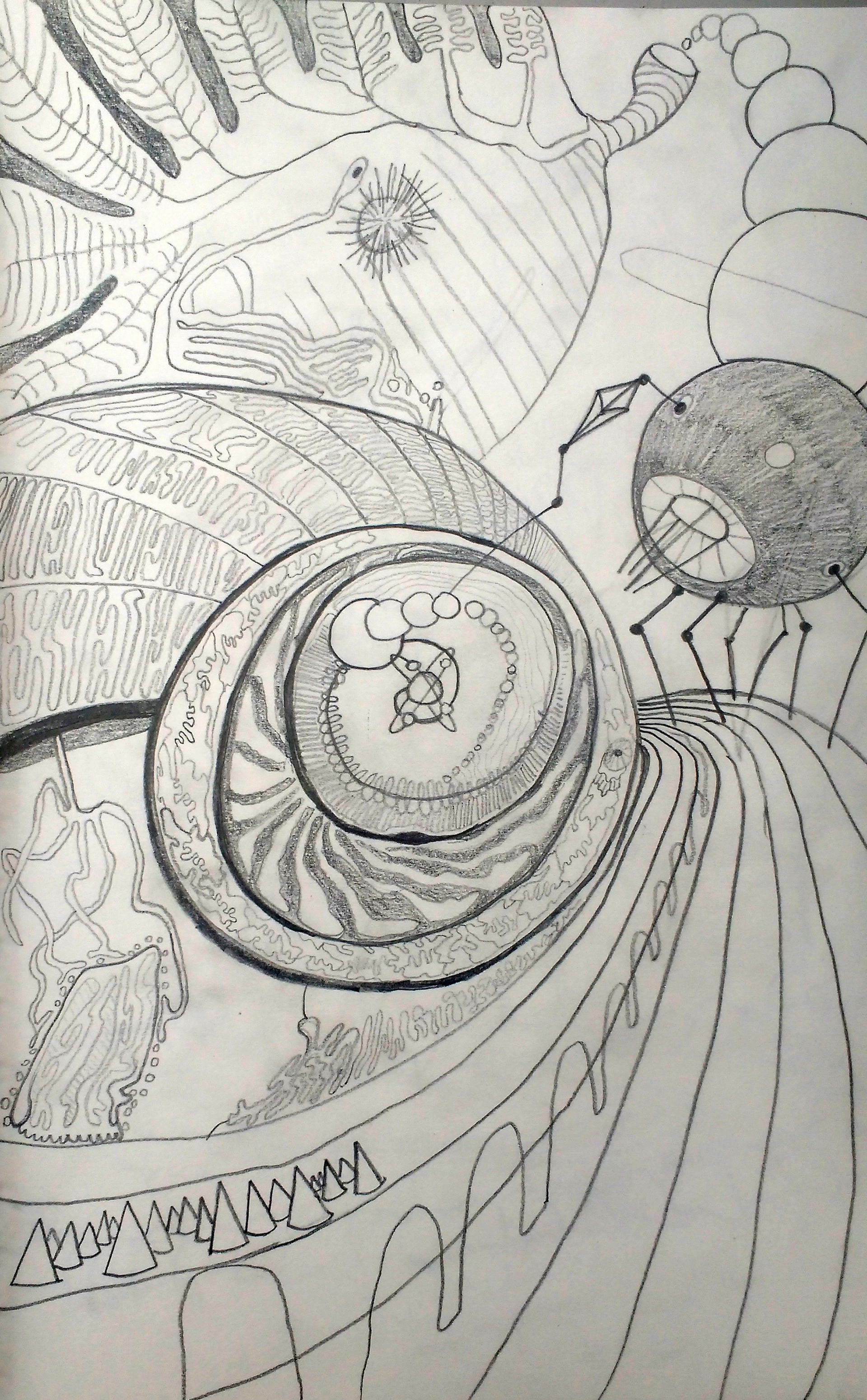

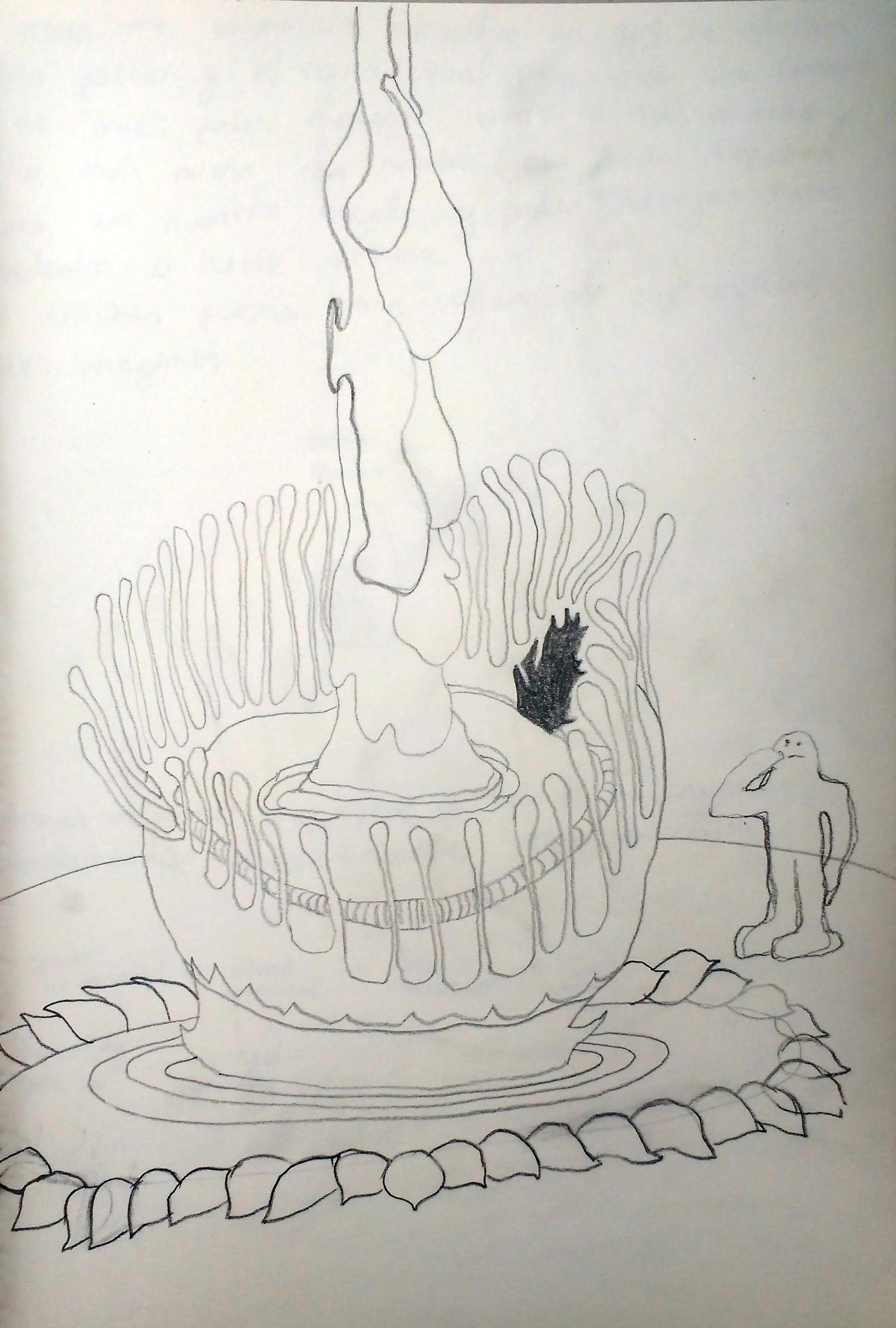


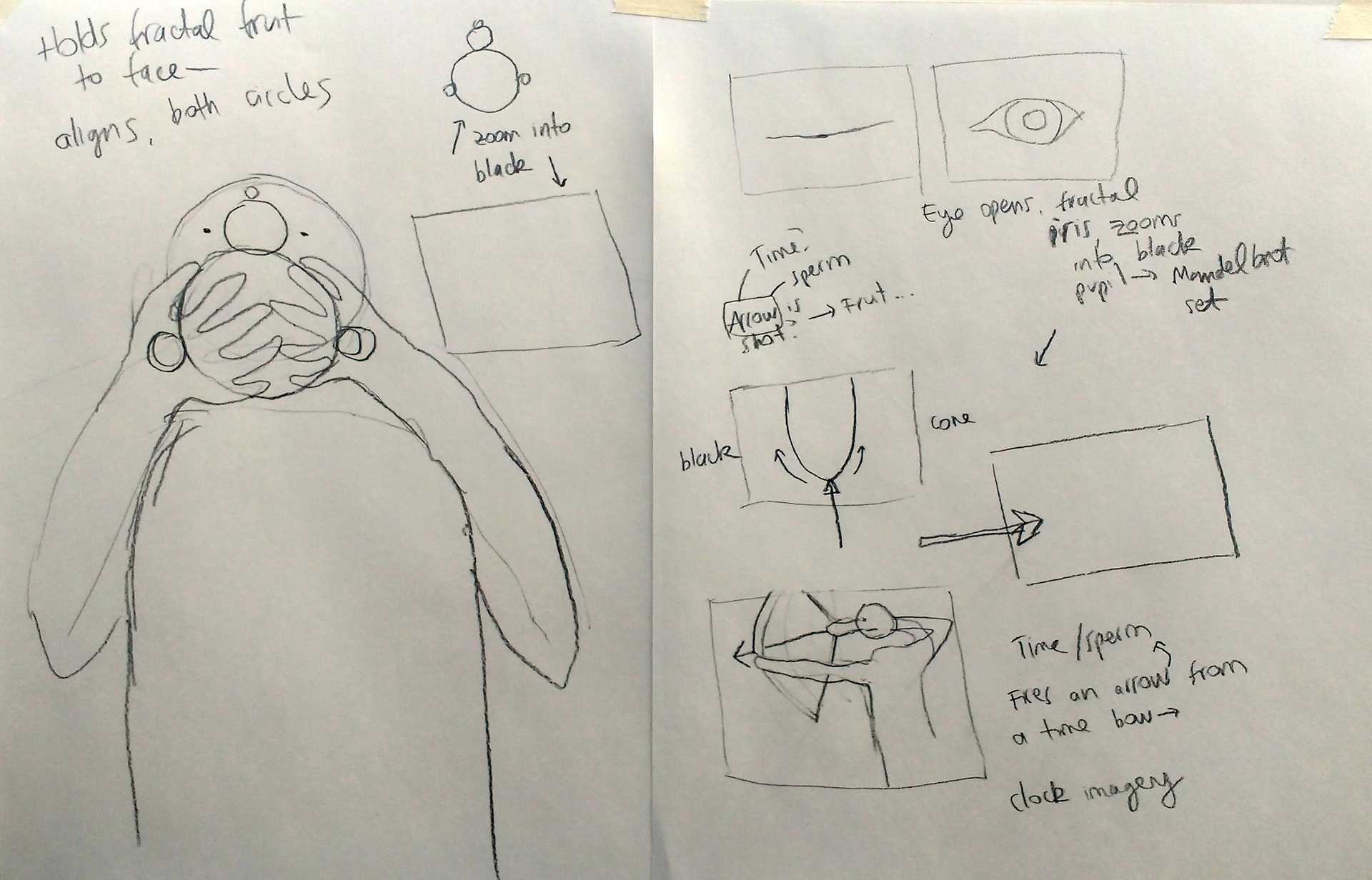

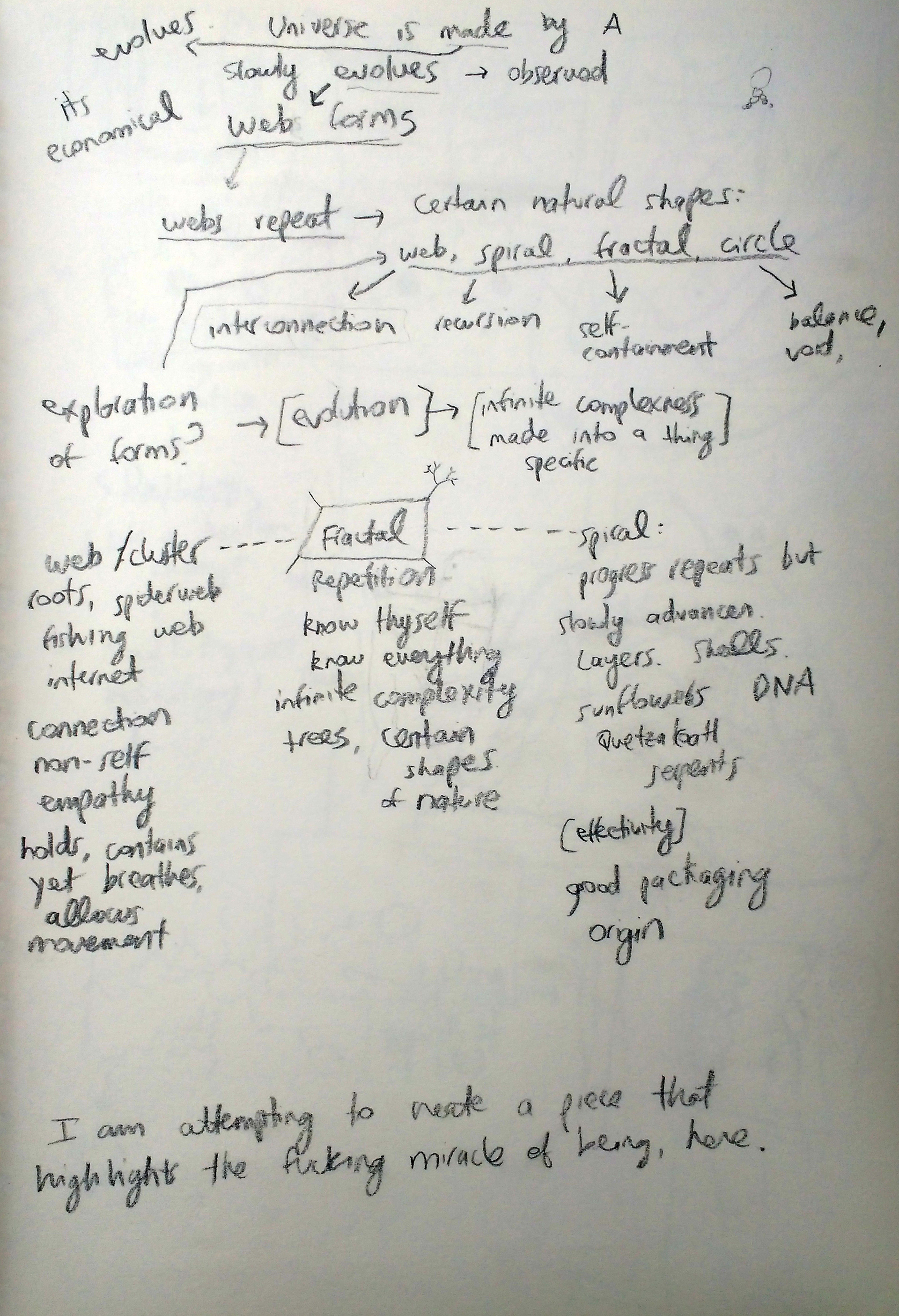
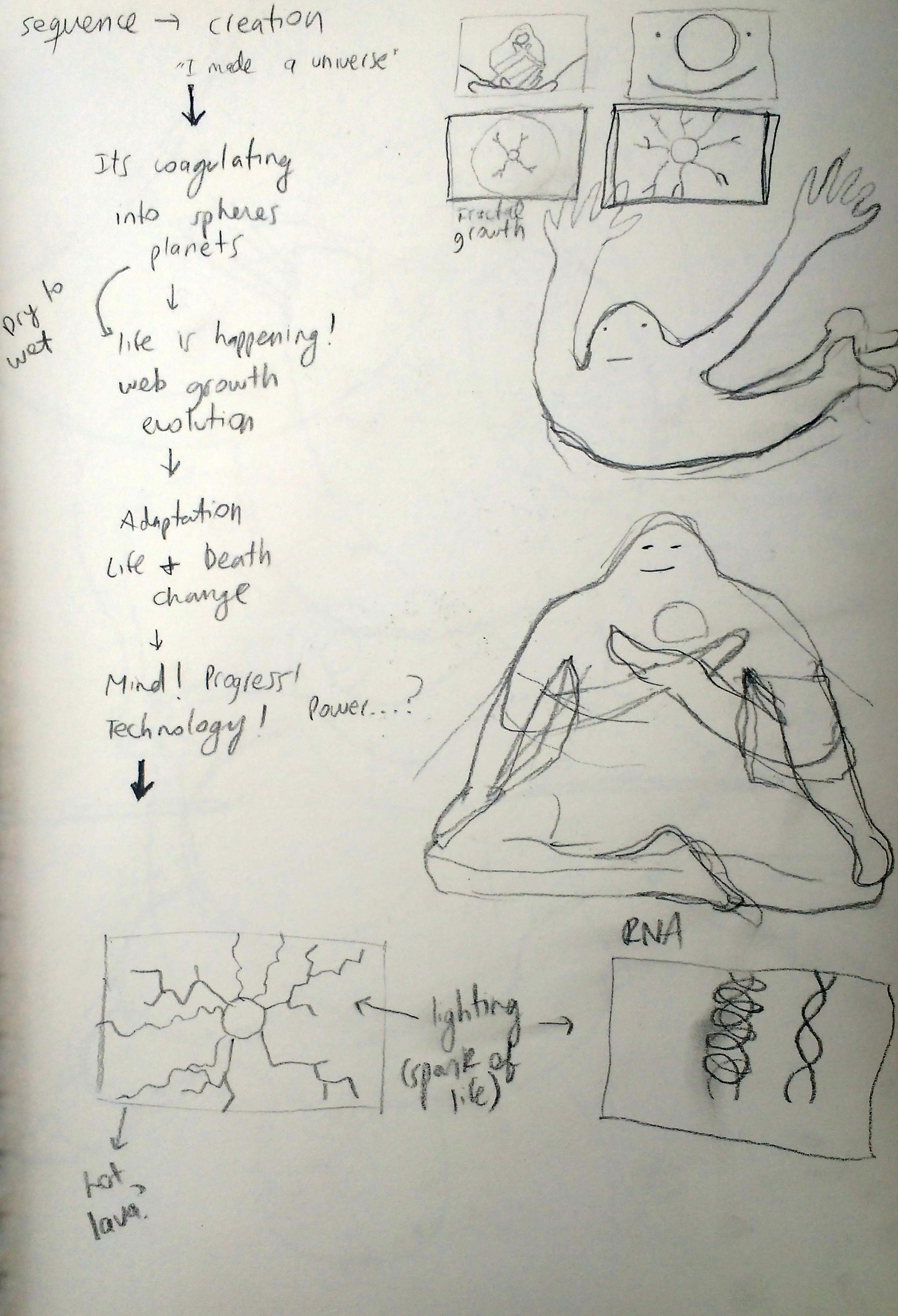



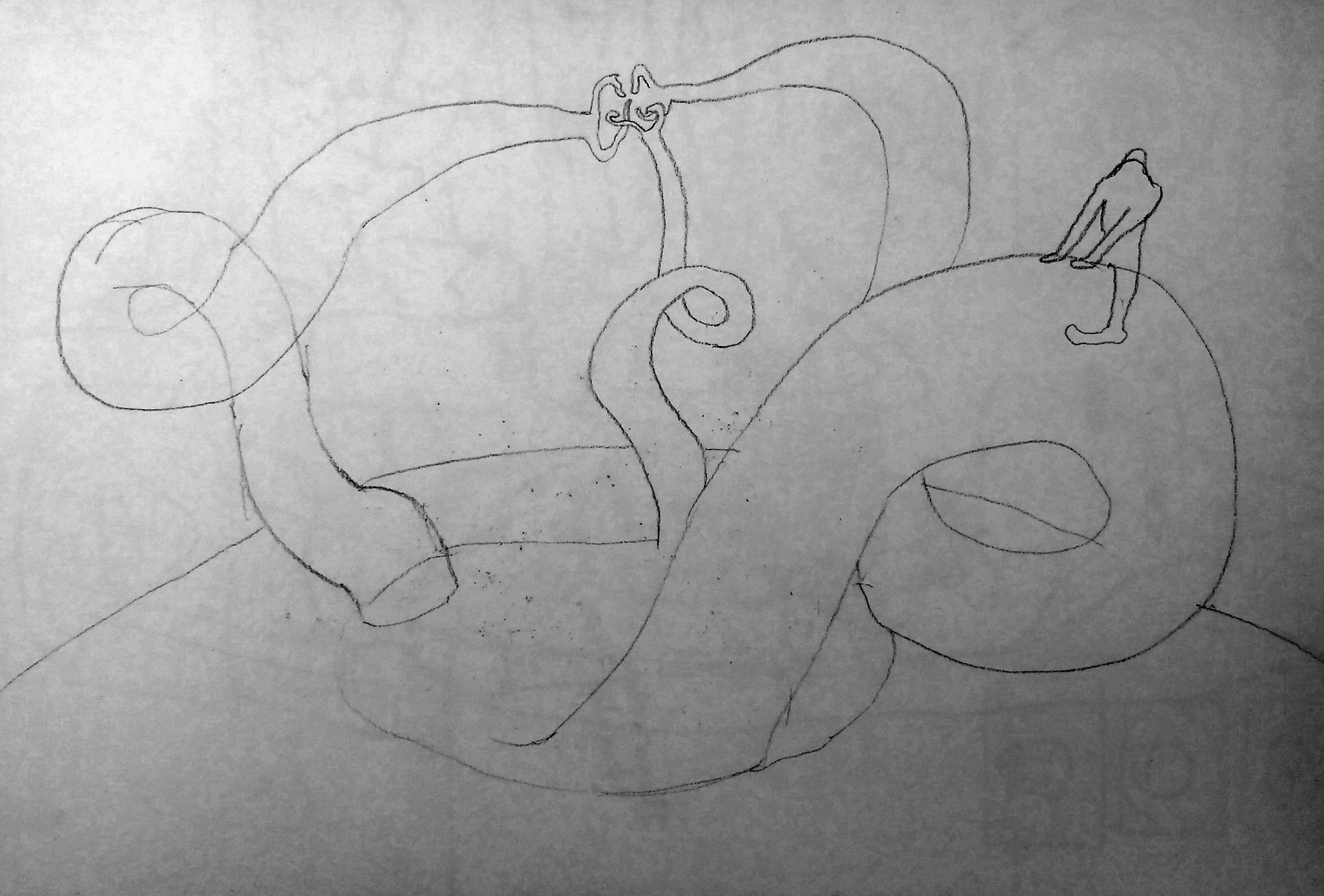

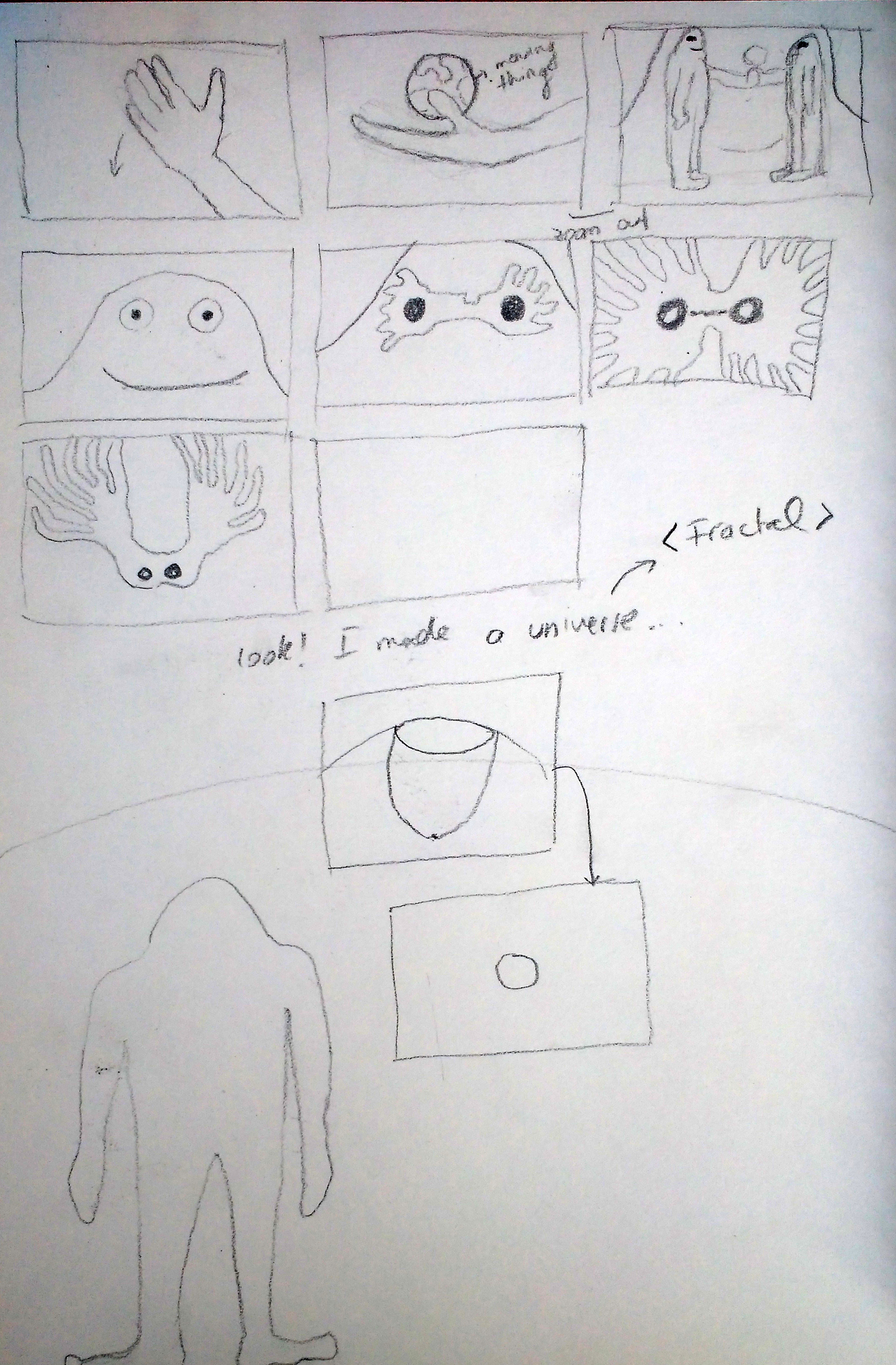
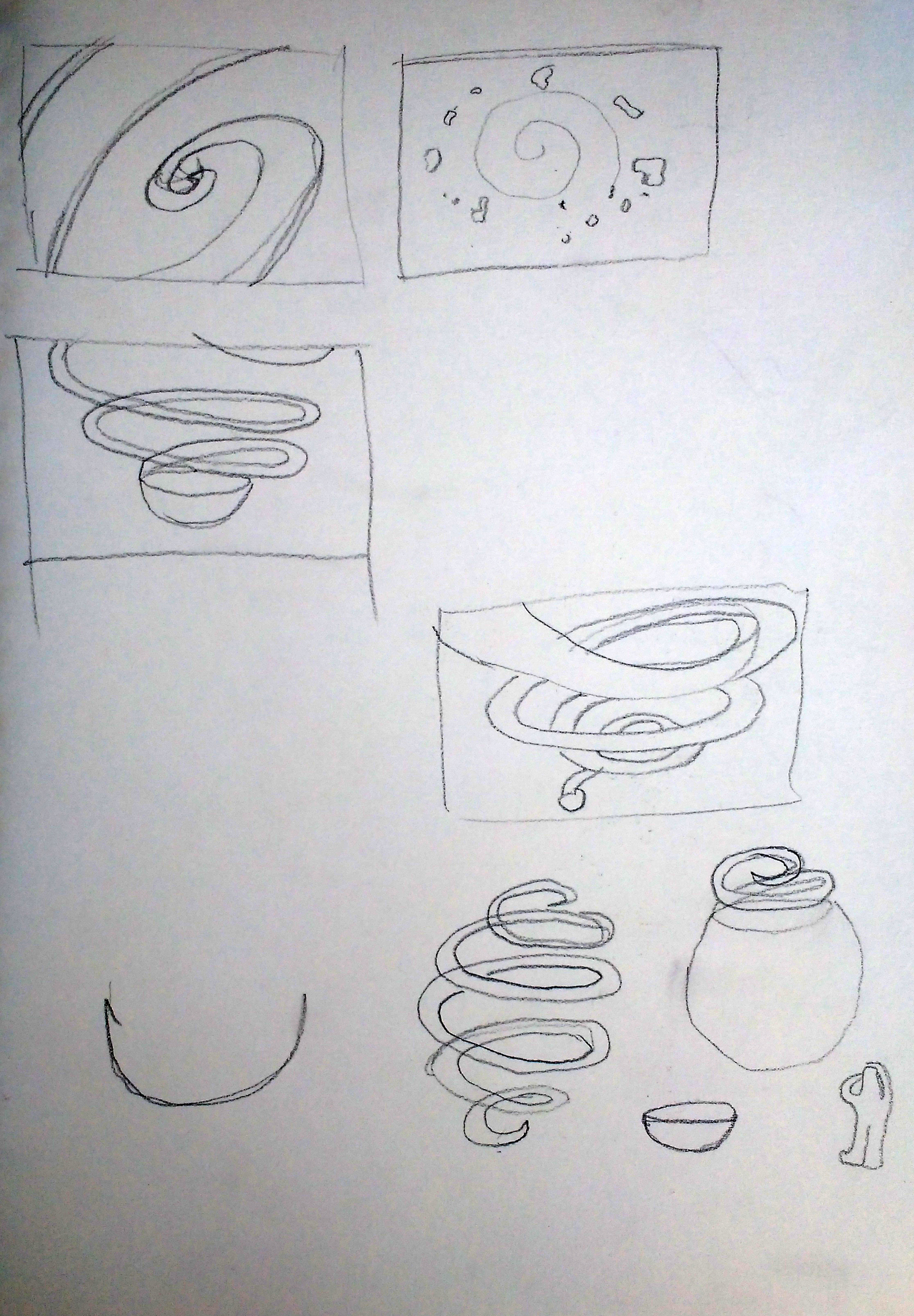
A big part of my creative practice during this year has been poetry, as a means of condensing, analysing and reflecting upon the body of ideas and concepts that inform my practice. Writing has always been a key aspect of my work as both an animator and a visual artist, having used it to explore relationships and forge metaphors which enable new understandings and perspectives.
Most of the writing I have done in the past has been personal, taking the form of stream of consciousness and other spontaneous, unplanned techniques, which I use in an almost therapeutic manner. However, for my current project, I have focused on condensing these open-ended texts into more concrete and rhythmical forms, using poetry to bring varied, disconnected ideas and intuitions into detailed and specific particles of meaning. Currently, my interest as an animator is to create pieces that create a sense of transcendental awe upon the audience: I intend to do this by using animation’s imaginative and limitless nature to explore notions of scale, place and time, bringing together onto the screen a wide breadth of disparate elements that couldn’t otherwise interact. A fantasy is established, in which the viewer finds their disbelief suspended, and a new way of understanding reality can be achieved.
Poetry, in turn, allows me to establish and delve into these fantastical relationships using a written form, experimenting with language to imagine spaces and situations in which things of different scales can co-exist within an imaginary perspective, revealing characteristics of themselves and each other. Writing poetry has allowed me to create specific situations that reveal more subtle and concise meaning about the elements in play, as well as charging them with precise emotional tones that further develop the significance and symbolic interplay of what would otherwise remain as merely absurdist and random imagery. Poetry challenges me to invent concrete sequences of images and metaphors, and by describing and explaining them I understand how they could work in a linear, narrative fashion.
I visualize the poems I have written as companion pieces to the animation I am planning to create, as well as to the paintings, drawings and other texts that are part of my artistic practice in general. They explain in detail the relationships and the conceptual ground from which my practice grows. Also, they function as separate pieces of writing that can be enjoyed by themselves, in which a specific vision of life and of the place we humans occupy within nature, viewed through an emotional lens, can be found.
Part of the challenge of creating this project was having to translate some of the poems from Spanish, my mother language. I had never translated poetry, which poses a very different challenge from prose. I approached this process intuitively, allowing myself to feel I was writing a new poem which was based on the Spanish version, instead of attempting to directly translate. Given the poem is my own, I could play around with words in English, without having to be completely literal. I find that in many aspects the poems improved by being translated, forcing me to cut unneeded elements and focus on the essential.
Semester 1:
References
"A Breakthrough In Higher Dimensional Spheres | Infinite Series | PBS Digital Studios". 2017. Youtube. https://www.youtube.com/watch?v=ciM6wigZK0w.
"A Thin Sheet Of Reality: The Universe As A Hologram". 2017. Youtube. https://www.youtube.com/watch?v=HnETCBOlzJs.
"Are We Living In An Ancestor Simulation? Ft. Neil Degrasse Tyson | Space Time". 2017. Youtube. https://www.youtube.com/watch?v=hmVOV7xvl58.
Clube, Victor, and Bill Napier. 1982. The Cosmic Serpent. 1st ed. New York: Universe Books.
"Hidden Dimensions: Exploring Hyperspace". 2017. Youtube. https://www.youtube.com/watch?v=h9MS9i-CdfY.
Krauss, Lawrence M, and Richard Dawkins. 2014. A Universe From Nothing. 1st ed. New York: Atria Books.
"National Geographic | Quantum Spacetime - Documentary 1080P". 2017. Youtube. https://www.youtube.com/watch?v=-HhT4bzslF8.
"Origin Of Life - How Life Started On Earth". 2017. Youtube. https://www.youtube.com/watch?v=xyhZcEY5PCQ.
"Pilot Wave Theory And Quantum Realism | Space Time | PBS Digital Studios". 2017. Youtube. https://www.youtube.com/watch?v=RlXdsyctD50.
"The Illusion Of Time (Fabric Of The Cosmos) NOVA HD". 2017. Youtube. https://www.youtube.com/watch?v=9Qu9XaF2K10.
Wolchover, Natalie. 2017. "The Quantum Thermodynamics Revolution | Quanta Magazine". Quanta Magazine. https://www.quantamagazine.org/quantum-thermodynamics-revolution/.
Wolchover, Natalie. 2017. "Digital Alchemist’ Sharon Glotzer Seeks Rules Of Emergence | Quanta Magazine". Quanta Magazine. https://www.quantamagazine.org/20170308-digital-alchemist-sharon-glotzer-interview-emergence/.
Zimmer, Carl. 2017. "The Surprising Origins Of Life’S Complexity". Quantamagazine.Org. https://www.quantamagazine.org/20130716-the-surprising-origins-of-lifes-complexity/.